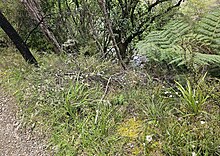Libertia mooreae
| Libertia mooreae | |
|---|---|

| |
| Libertia mooreae at the Auckland Botanic Gardens | |
| Scientific classification | |
| Kingdom: | Plantae |
| Clade: | Tracheophytes |
| Clade: | Angiosperms |
| Clade: | Monocots |
| Order: | Asparagales |
| Family: | Iridaceae |
| Genus: | Libertia |
| Species: | L. mooreae |
| Binomial name | |
| Libertia mooreae Blanchon, B.G.Murray & Braggins, 2002 | |
Libertia mooreae is a species of flowering plant in the family Iridaceae. The plant was first described by Dan Blanchon, Brian Grant Murray and John E. Braggins in 2002, and is native to New Zealand.[1]
Etymology
The species was named after New Zealand botanist Lucy Moore.[2][3]
Taxonomy
The specimens of the plant were previously identified as Libertia grandiflora.[2] Leaf structure (equally spaced veins) and its smaller plant size were used to distinguish the species morphologically.[2]
Description
Libertia mooreae consists of leafy fans with white flowers.[2] Plants differ morphologically between areas, with specimens found in the Marlborough District being smaller and more grass-like, while plants in the Aorere River area are much larger.[2]
Distribution and habitat

Libertia mooreae is endemic to New Zealand, known to occur in the northern South Island in the Tasman District and Marlborough District, and the southern North Island, as far north as the Manawatū Gorge.[2] Plants have commonly been found in Nothofagus and Podocarpus forest edges, among mānuka scrub, and has also been found in ridges, cliffs, rocky river banks.[2]
References
- ^ "Libertia cranwelliae". Global Biodiversity Information Facility. Retrieved 13 July 2024.
- ^ a b c d e f g Blanchon, D. J.; Murray, B. G.; Braggins, J. E. (September 2002). "A taxonomic revision of Libertia (Iridaceae) in New Zealand". New Zealand Journal of Botany. 40 (3): 437–456. doi:10.1080/0028825X.2002.9512805. ISSN 0028-825X. Wikidata Q54557803.
- ^ Young, Maureen; Cameron, Ewen. "Plants named for our "two Lucies". An occasional paper in the series "Plants named for ABS members"". Austral Ecology. 34 (1): 69–76.
External links
- Holotype of Libertia mooreae at the Manaaki Whenua – Landcare Research website
